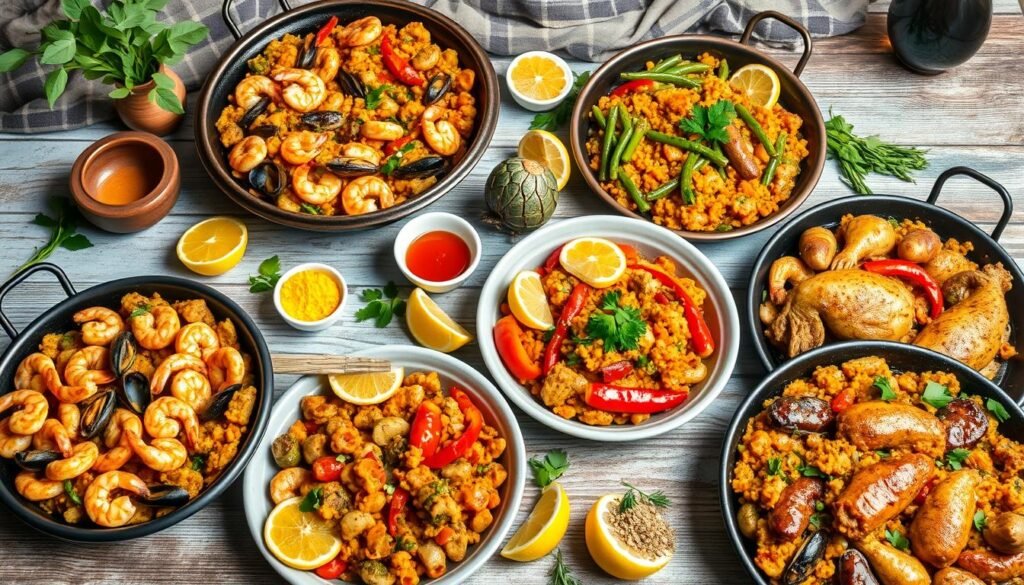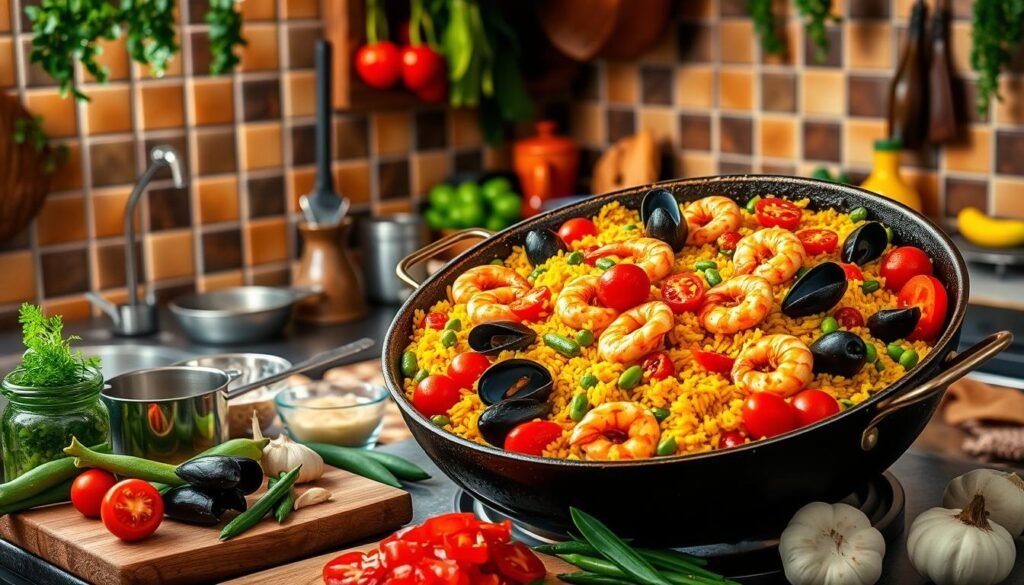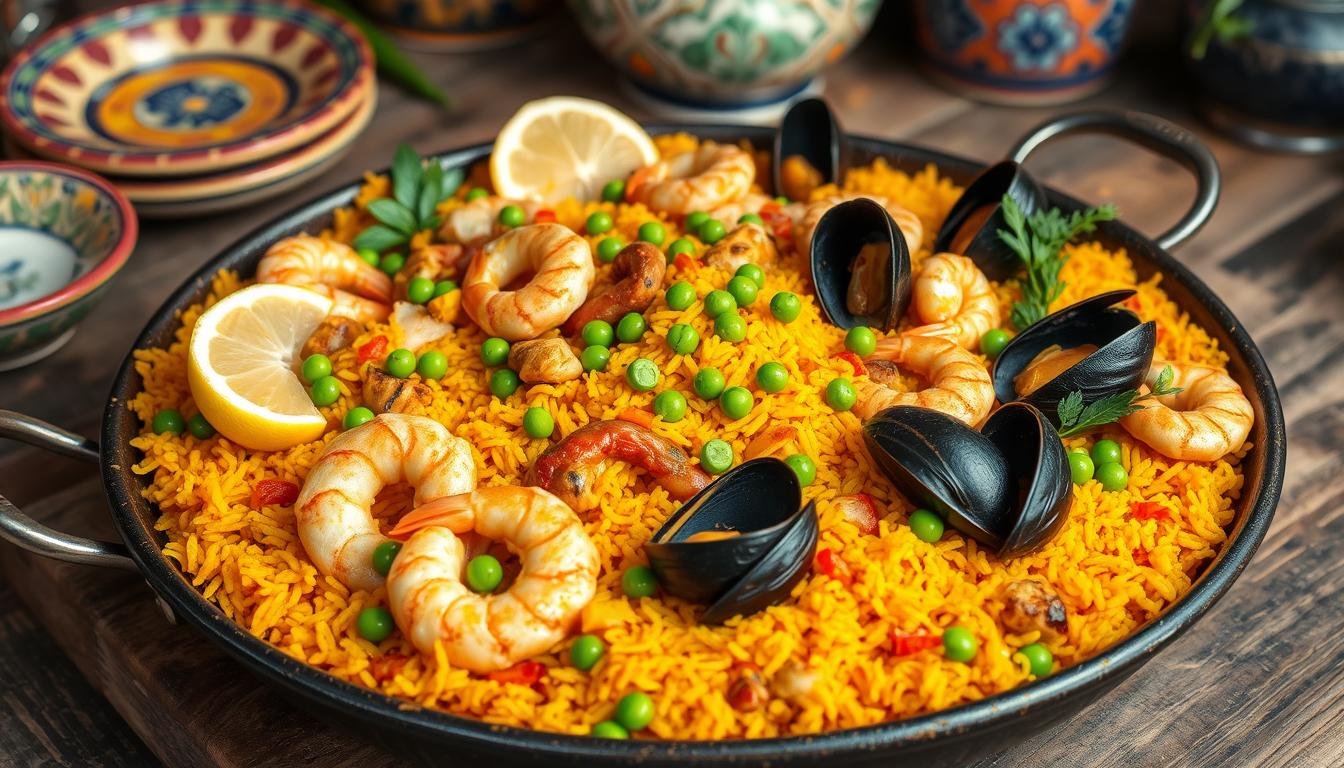Savor the Essence of Spain Authentic Spanish Paella
The first time I tasted authentic Spanish paella in Valencia, it changed me. It showed me that this dish is more than food—it’s a journey through Spain’s culture. Born in the sunny rice fields of Comunidad Valenciana, it’s a dish filled with tradition, passion, and community.
Starting your paella adventure here is exciting. Paella is not just rice; it’s a story of family, community, and Spanish spirit. From the Bomba rice to the socarrat, every part makes it a special experience.
Whether you’re a pro chef or just starting, this guide will help you make a true Spanish paella. It’s a way to bring Valencia’s favorite dish to your table.
Table of Contents
The Rich History of Spanish Paella
Explore the world of traditional Spanish cuisine and learn about Valencia paella’s story. This dish is more than food; it’s a journey through Spanish culture.
Paella’s history begins in Valencia’s fields. Farm workers created it during their breaks in the 14th and 15th centuries. The name “paella” comes from the cooking pan, showing its deep connection to cooking.
Origins of a Culinary Treasure
The Valencia paella tradition started with simple ingredients. Early versions included:
- Green vegetables
- Rabbit
- Duck
- Snails
- Local seasonings
“Paella is not just food; it’s a celebration of Spanish culture and community.”
Cultural Significance
Paella’s role changed over time. It went from a workers’ meal to a symbol of Spanish identity. During General Francisco Franco’s rule, it became a powerful symbol of national pride.
| Historical Period | Paella’s Role |
|---|---|
| 14th-15th Centuries | Laborers’ lunch |
| 18th Century | Spread across Spain |
| 20th Century | National culinary icon |
Traditional Cooking Techniques
Paella’s preparation is an art. Socarrat, the crispy rice layer, is a favorite. Traditionally, men cooked paella, making it a social event.
Key Ingredients for a Perfect Paella
To make a true paella, you need the right ingredients. They bring out the dish’s rich flavors. Start by learning about the key parts that make this Spanish dish special.
The Role of Rice Varieties
Paella rice is the base of this dish. Bomba rice is the top pick for real paella. It has special qualities:
- It can soak up to three times its volume in liquid
- It keeps its grain texture
- It holds onto flavors well without getting mushy
Meats and Seafood Choices
Seafood paella is full of tasty proteins. Real recipes often include:
- Fresh jumbo shrimp (about 12 pieces)
- Mussels (10-12 per serving)
- Chicken, rabbit, or chorizo can also be added
Essential Spices and Seasonings
“The soul of paella lies in its spices” – Spanish Culinary Tradition
Boost your paella with these important spices:
- Saffron threads (1 teaspoon for authentic flavor)
- Smoked paprika
- Fresh garlic
- Olive oil
Toasting saffron brings out its full aroma. This adds a deep flavor that makes your paella stand out.
Cooking Methods: Traditional vs. Modern
Learning to make paella at home means understanding its unique cooking techniques. The way you prepare it can greatly affect its flavor and authenticity. This makes your paella experience feel like a trip to Spain.
Choosing the right cookware is key for making the best paella. Traditional Valencian cooks use specific tools and methods. These elevate paella beyond just a rice dish.
The Authentic Paella Pan
The paella pan, or paellera, is essential for perfect paella. Unlike regular pans, these wide, shallow pans have special benefits:
- They ensure even heat distribution
- They create the crispy bottom layer called socarrat
- They help rice cook in a thin, even layer
Outdoor Cooking: The Valencian Tradition
Authentic paella cooking is all about outdoor cooking. The Valencian method uses an open flame. They often use orange or pine tree branches for unique aromas.
“True paella is not just a dish, it’s a cultural experience that connects you to generations of Spanish culinary tradition.”
Even without an open fire, you can still make traditional paella. Just manage the heat well and use quality ingredients. Whether using a traditional pan or modern cookware, honor the dish’s heritage.
Modern Adaptations
Today, cooking paella is easier than ever. Gas stoves, electric cooktops, and special paella pans make it simple for anyone to make this classic Spanish dish.
Popular Variations of Paella

Spanish food is incredibly diverse, and paella is a perfect example. It has changed over time, becoming many tasty variations. These changes reflect different tastes and dietary needs.
Let’s look at the most loved paella styles. They have won the hearts of food lovers in Spain and worldwide:
Seafood Paella: A Coastal Delicacy
Seafood paella is a true Mediterranean feast. It’s a summer favorite in coastal areas. It’s filled with fresh seafood like:
- Fresh shrimp
- Succulent mussels
- Tender clams
- Flavorful fish
“Seafood paella captures the essence of Spanish maritime cuisine in every bite.”
Mixed Paella: A Hearty Combination
Mixed paella is a mix of meat and seafood. It has chicken, rabbit, and fresh seafood. It’s loved for its hearty and satisfying taste.
Vegetarian Paella: Plant-Based Perfection
Vegetarian paella is becoming more popular. It focuses on fresh veggies and bold flavors. It uses ingredients like:
- Bell peppers
- Artichokes
- Tomatoes
- Onions
Every type of paella shows how versatile this Spanish dish is. It’s more than just rice.
How to Choose the Right Rice
Choosing the right paella rice is key to a true Spanish food experience. The right rice can make your dish go from good to great. It brings the true taste of traditional Valencian cooking to your table.
Knowing about rice varieties is essential for making great paella. Spanish chefs know that not all rice is the same for this dish.
Short-Grain vs. Long-Grain Rice
For real paella rice, short-grain varieties are the best. They have special traits that make them perfect for paella:
- Bomba rice: The top choice for paella rice
- It can soak up to three times its volume in liquid
- It stays firm and holds onto flavors well
“Bomba rice is the secret weapon of authentic Spanish paella” – Valencia Culinary Institute
Top Brands to Consider
When looking for paella rice, remember these top brands:
| Rice Variety | Origin | Best For |
|---|---|---|
| Bomba Rice | Calasparra, Spain | Perfect flavor absorption |
| Senia Rice | Valencia Region | Traditional paella texture |
| Calrose Rice | California, USA | Widely available alternative |
Pro tip: Don’t use long-grain rice like Jasmine or Basmati. They don’t soak up liquid well and don’t have the right texture for paella. Your goal is to make a dish that truly captures the essence of Spanish food.
Essential Cooking Tips for Beginners

Learning to make paella at home might seem hard, but it’s easier than you think. With the right tips, you’ll soon be making this Spanish dish like a pro. Paella needs precision and understanding of key cooking principles to turn simple ingredients into a masterpiece.
To make a real paella, start with a strong flavor base. Experts say focus on two main things: making a great broth and controlling the heat.
Mastering the Perfect Broth
A great paella starts with a fantastic broth. Your stock should be rich and full of flavor. Use:
- Fresh seafood or chicken bones
- Aromatic vegetables
- Saffron for distinctive color and taste
- Herbs like rosemary and thyme
“The secret to an incredible paella lies in your broth’s depth of flavor.” – Chef Maria Rodriguez
Temperature and Timing Techniques
When learning about paella, knowing how to manage heat is key. The best cooking process is:
- Start with high heat to create sofrito base
- Reduce to medium heat when adding rice
- Maintain consistent low heat during final cooking stages
The goal is to get socarrat – that crispy rice bottom that’s a hallmark of paella. Don’t stir your rice too much. Letting it get a golden crust takes patience and precision.
Rice Selection and Preparation
Use medium-grain Spanish rice like Bomba. It soaks up more liquid than regular rice. Soak your rice for 15-20 minutes before cooking. This helps it cook evenly and absorb flavors better.
Pairing Wines with Paella
Finding the perfect wine can make your Spanish food experience even better. It can take your traditional Spanish cuisine to new levels. Wine pairing is an art that brings out the rich flavors of paella, making your meal unforgettable.
Understanding how wine and paella work together is key. You need to think about the dish’s ingredients and how it’s cooked.
White Wines that Complement
White wines are great with paella, especially if it has seafood. Here are some top picks:
- Albariño: A crisp, mineral-driven wine perfect for seafood paella
- Verdejo: A lean, high-acidity wine with refreshing characteristics
- Chardonnay: Provides a balanced flavor profile
Red Wines for Bold Flavors
For meatier paella, bold red wines are the way to go. They make for a perfect dining experience:
| Wine | Paella Type | Flavor Profile |
|---|---|---|
| Tempranillo | Mixed Paella | Full-bodied, rich |
| Ribera del Duero | Meat Paella | Complex, intense |
“Wine is the perfect companion to paella, bridging flavors and creating culinary harmony.”
When picking your wine, think about what’s in your paella. The right wine can turn a good meal into an amazing experience.
Serving Suggestions and Presentation
Presenting Spanish food is an art form. It turns a delicious dish into a memorable meal. When serving paella, the presentation is key.
The authentic way to serve paella is communal. It brings people together. Here are some tips for a great paella experience:
Traditional Accompaniments
- Alioli (garlic mayonnaise) as a classic dipping sauce
- Fresh lemon wedges to brighten the flavors
- Crusty bread for soaking up delicious pan juices
- Crisp white wine from Spanish regions
Creative Garnishing Ideas
Make your paella look great with these garnishing tips:
- Sprinkle fresh chopped parsley
- Arrange grilled lemon slices around the pan
- Scatter edible flowers for a pop of color
- Use rosemary sprigs as elegant garnishes
| Serving Recommendation | Details |
|---|---|
| Plate Type | Large, shallow porcelain dishes |
| Portion Size | Approximately 625 calories per serving |
| Serving Style | Directly from the paella pan for authentic experience |
“In Spain, paella is not just a dish, it’s a celebration of community and flavor.”
The secret to great paella presentation is to highlight the ingredients. Create a welcoming, shared dining experience.
Embracing the Paella Experience
Dive into the heart of Spanish food by turning your next gathering into a real paella celebration. Traditional Spanish cuisine is more than just food—it’s a lively social experience. It brings people together through shared food traditions.
Hosting a paella party takes you straight to Valencia’s warm streets. There, this iconic dish has been loved for over 400 years.
Preparing paella is an art that’s more than cooking. It’s about creating a space where everyone comes together. They share stories and enjoy each bite.
The key is to use a big pan for family-style dining. Choose top-notch ingredients like Spanish chorizo, fresh seafood, and perfectly cooked rice. This ensures an authentic flavor that captures Spanish culinary heritage.
Hosting a Paella Party
When planning your paella party, think about what makes this dish special. Invite friends to help cook, letting them enjoy making a meal together. Serve the paella from the pan, encouraging family-style eating and lively talks.
Remember, a great paella party is about making memories. It’s about sharing cultural experiences and celebrating Spanish cuisine’s rich traditions.
Cultural Traditions and Celebrations
Embrace Spanish gatherings by making your paella party more than just a meal. Play traditional Spanish music and use colorful tableware. Create an atmosphere that shows the vibrant culture behind this beloved dish.
Your guests will love exploring Spanish food traditions. They’ll enjoy a culinary experience that goes beyond just eating a delicious meal.
FAQ
What makes authentic Spanish paella different from other rice dishes?
What type of rice is best for making paella?
Can I make paella without a traditional paella pan?
What are the most popular types of paella?
How important is saffron in paella?
What wine pairs best with paella?
Can paella be made vegetarian or vegan?
What is the traditional way to serve paella?
How difficult is it to make paella at home?
What is socarrat, and why is it important?
Source Links
- Authentic Paella Valenciana – https://letseattheworld.com/authentic-paella-valenciana/
- Authentic Spanish Paella Recipe: A Flavorful Culinary Journey – https://www.dritestuff.com/blogs/recipies/authentic-spanish-paella-recipe-a-flavorful-culinary-journey
- Savor the Paella feast : Crafting an Unforgettable Spanish dish – – https://destinationcuisines.com/savor-the-paella-feast-crafting-an-unforgettable-spanish-dish/
- Discover the history of this Spanish dish – https://www.barcelo.com/pinandtravel/en/origins-of-paella-traditional-paella/
- The Origin and History of Spanish Paella (Plus Spanish Vocab!) – https://www.spanish.academy/blog/the-origin-and-history-of-spanish-paella-plus-spanish-vocab/
- A history of Paella | What is Paella – https://www.seasonedpioneers.com/a-history-of-paella/?srsltid=AfmBOoq5gSq-T7zRlviJUAji7g41HazYa1J_PLWgtvROks80jHpe729w
- Spanish Paella Recipe – Tastes Better from Scratch – https://tastesbetterfromscratch.com/paella/
- How to make perfect paella – https://www.bbcgoodfood.com/howto/guide/perfect-paella
- Paella – https://en.wikipedia.org/wiki/Paella
- The History of Paella (and Why You Should to Learn to Master it at Home) – https://www.thechefandthedish.com/post/2017/03/23/the-history-of-paella-and-why-you-need-to-learn-to-master-it-at-home
- The Ultimate Guide to Spanish Paella | Le Gourmet Central – https://legourmetcentral.com/our-blog/the-ultimate-guide-to-spanish-paella-/?srsltid=AfmBOorxsTIdzv13NNulmXEArLLhLrKsR_kVUv6s3PJNWggLWNo6sNKD
- How many types of paella are there? 10 different recipes for you – https://blog.fuertehoteles.com/en/food-and-drink/spanish-paella-recipes/
- 11 Satisfying Paella Recipes – https://www.foodandwine.com/seafood/paella
- Spanish Paella Recipe (Seafood, Chicken, & Chorizo) – https://houseofnasheats.com/paella/
- How to Select the Right Rice for Paella – https://www.thespruceeats.com/the-best-rice-for-paella-3082839
- How to find the best paella in Spain – https://viewfromlavila.com/2018/01/04/paella-and-rice-dishes-a-user-guide/
- Choosing the best rice for your paella – https://paellabarcelona.com/types-of-rice-for-paella/
- Easy Seafood Paella Recipe (Full Tutorial) | The Mediterranean Dish – https://www.themediterraneandish.com/easy-seafood-paella-recipe/
- Easiest Paella Ever · i am a food blog – https://iamafoodblog.com/paella-recipe/
- Paella Wine Pairings | Armchair Sommelier – https://armchairsommelier.com/food-and-pairings/paella-wine-pairing/
- Best wine with paella – wine pairing with paella – https://winetourismspain.com/blog/which-wine-good-paella/
- Paella With a Caribbean Twist – https://cookingwithria.com/2024/11/paella-with-a-caribbean-twist/
- The Perfect Union: Serving Up Traditional Spanish Paella on Elegant Porcelain – https://malacasa.com/blogs/news/elegant-porcelain-for-traditional-paella?srsltid=AfmBOoqBNcBtLmgoa2ABuhV4QW5xQLVBaCtv_tLNDtek3dYgDy2pvH4P
- Paella Primer — The Naked Whiz’s Ceramic Charcoal Cooker Page – https://www.nakedwhiz.com/paella/paella.htm?printerfriendly
- How to Make Simple Spanish Paella – https://thetableart.com/2018/08/17/simple-spanish-paella/
- Discover Our Top-Rated Cooking Classes at Gastronomic Arts Barcelona – https://www.gastronomicartsbarcelona.com/

